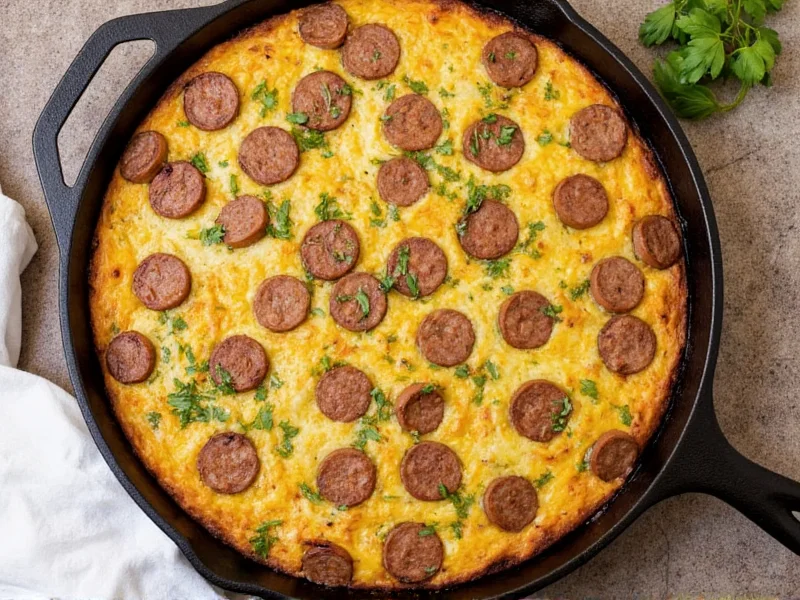A sausage frittata transforms simple ingredients into a satisfying meal that works equally well for weekend brunches or weekday breakfasts. Unlike scrambled eggs or omelets, this Italian-inspired dish bakes entirely in the oven after initial stovetop preparation, creating a fluffy texture throughout without flipping. The combination of savory sausage, melty cheese, and customizable vegetables makes it a crowd-pleasing option that accommodates various dietary preferences with simple substitutions.
Essential Ingredients for the Best Sausage Frittata
Creating an exceptional sausage frittata starts with quality components. While recipes vary, these elements form the foundation of a successful dish:
| Ingredient | Recommended Amount | Substitution Options |
|---|---|---|
| Eggs | 8 large | 6 eggs + 4 egg whites for lower calories |
| Italian sausage | 12 oz (mild or hot) | Breakfast sausage, turkey sausage, or plant-based alternative |
| Cheese | 1 cup shredded | Feta, cheddar, or goat cheese |
| Vegetables | 2 cups total | Onion, bell peppers, spinach, mushrooms, or zucchini |
| Milk or cream | 2 tablespoons | Almond milk or omit for dairy-free |
Step-by-Step Cooking Instructions
Follow these professional kitchen techniques to achieve a perfectly textured sausage frittata every time:
- Preheat oven to 375°F (190°C) and position rack in the center.
- Cook sausage in an oven-safe skillet over medium heat until browned (5-7 minutes). Remove with slotted spoon, leaving 1 tablespoon fat in pan.
- Sauté vegetables until tender (5 minutes). Onions should be translucent, spinach wilted.
- Whisk eggs with salt, pepper, and milk until thoroughly combined but not frothy.
- Combine ingredients in skillet: cooked sausage, vegetables, and 3/4 cup cheese mixed into egg mixture.
- Pour mixture back into preheated skillet, smoothing the top with a spatula.
- Bake 15-18 minutes until edges pull away from pan and center is just set (no liquid jiggle).
- Rest 5 minutes before slicing to allow structure to set.
Avoiding Common Frittata Mistakes
Even experienced cooks encounter issues with frittatas. These troubleshooting tips ensure success:
- Rubbery texture: Overcooking is the primary culprit. Remove from oven when center still has slight jiggle—it will continue cooking off-heat.
- Soggy bottom: Ensure vegetables release moisture before adding eggs. Sauté mushrooms and zucchini separately to remove excess water.
- Difficulty removing from pan: Properly season and preheat your cast iron or oven-safe skillet before adding ingredients.
- Flat appearance: Whisk eggs thoroughly but avoid incorporating too much air, which creates large bubbles during baking.
Delicious Variations and Customizations
Adapt this basic sausage frittata recipe to suit different tastes and dietary needs:
- Vegetarian option: Replace sausage with 1 cup cooked lentils and add sun-dried tomatoes for umami flavor.
- Low-carb version: Increase vegetable content with broccoli florets and asparagus while reducing cheese slightly.
- Keto-friendly adaptation: Use full-fat cheese and add 1/4 cup heavy cream to the egg mixture for richer texture.
- Meal prep strategy: Slice into portions, wrap individually in parchment paper, and freeze for up to 3 months. Reheat in oven at 350°F for 15 minutes.
Serving Suggestions and Storage Tips
Maximize your sausage frittata experience with these presentation and preservation techniques:
Pair your frittata with fresh fruit salad, avocado slices, or a simple arugula salad with lemon vinaigrette. For brunch gatherings, cut into small squares and serve with toothpicks as an elegant finger food. Leftovers maintain quality when stored properly:
- Refrigeration: Keep in airtight container for up to 4 days
- Freezing: Wrap individual portions in parchment paper, then place in freezer bag for up to 3 months
- Reheating: Oven method preserves texture best—350°F for 15 minutes or until heated through
- Microwave alternative: 60-90 seconds covered with damp paper towel to prevent drying
Frequently Asked Questions
Can I make sausage frittata ahead of time?
Yes, sausage frittata is ideal for meal prep. Prepare the entire dish, cool completely, then slice into portions. Store in airtight containers in the refrigerator for up to 4 days or freeze for up to 3 months. Reheat in the oven at 350°F for best texture retention.
What's the best sausage for frittata?
Mild or hot Italian sausage works best for traditional flavor, but breakfast sausage, turkey sausage, or plant-based alternatives all work well. Choose sausage with 15-20% fat content for optimal moisture and flavor without excessive grease.
Why did my frittata turn out rubbery?
Rubbery texture typically results from overcooking. Remove your frittata from the oven when the center still has a slight jiggle—residual heat will continue cooking it. Using too many egg whites or high oven temperatures can also create tough texture.
Can I make sausage frittata without dairy?
Absolutely. Omit the cheese and milk/cream, and add 2 tablespoons nutritional yeast for cheesy flavor. For creamier texture without dairy, blend 1/4 avocado into the egg mixture before baking.
How do I prevent a soggy frittata bottom?
Ensure vegetables release their moisture before adding eggs. Sauté high-water-content vegetables like mushrooms and zucchini separately until dry. Pat cooked sausage with paper towels to remove excess grease before incorporating into the egg mixture.











 浙公网安备
33010002000092号
浙公网安备
33010002000092号 浙B2-20120091-4
浙B2-20120091-4